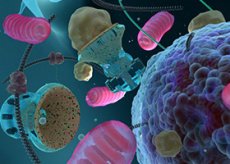New publications
Nanobiotechnology will be used to treat microbial infections
Last reviewed: 02.07.2025

All iLive content is medically reviewed or fact checked to ensure as much factual accuracy as possible.
We have strict sourcing guidelines and only link to reputable media sites, academic research institutions and, whenever possible, medically peer reviewed studies. Note that the numbers in parentheses ([1], [2], etc.) are clickable links to these studies.
If you feel that any of our content is inaccurate, out-of-date, or otherwise questionable, please select it and press Ctrl + Enter.

Nanotechnologists have delighted us with another discovery: this time, scientists have indicated the possibility of using microrobots and micromotors to eliminate microbial infections in the digestive tract. Micromotors are no larger than half the thickness of a human hair. They are capable of moving along the mucous surface of the stomach and neutralizing excess acid, after which the nanobioelectric device secretes an antibiotic that destroys the Helicobacter bacterium. The main developers of the project are nanotechnologist Dr. Joseph Wang and Professor Liangfang Zhang, representing the Jacobs College of Engineering (University of California - San Diego). The researchers were able to "force" the micromotor to move inside the body and, if necessary, secrete drugs. According to scientists, the created method will become the basis for the newest era of treatment of gastrointestinal diseases.. Previously, most drugs administered into the stomach were neutralized in an acidic environment. Now, both antibiotics and enzyme or protein agents can be freely administered into the digestive system. In order to create protection for the administered drug, doctors previously used a specific acid-resistant coating for drugs. And to weaken the effect of acid, they used proton pump inhibitors (for example, the well-known Omez and Omeprazole). But such treatments were not always reliable. In addition, such treatment was long-term, expensive, and accompanied by a large number of side effects. With the use of nanotechnology, it became possible to deliver the drug to its destination and at the same time "prepare the ground" for its effective action. Micromotors penetrate the stomach cavity, stabilize the acidity level to the required values, and only then release the drug. "Everything ingenious is simple. The antimicrobial drug will do its job without being damaged by the aggression of the acidic environment. Now everything is solved at once: there is no need for staged long-term treatment. The medicine works simply and reliably,” explains scientist Berta Esteban Fernandez de Avila. As the project managers explained, each microrobot and micromotor has a spherical magnesium core, covered with a protector based on titanium dioxide. Under the protector is hidden a dose of the antibacterial drug clarithromycin, which is released only when a certain level of acidity of the environment is reached. The last surface layer of the nanoparticle is chitosan, the function of which is to hold the micromotor near the walls of the stomach. After the acid neutralizer starts to work, hydrogen microgases are released: they, in turn, are an additional pushing force for the micromotor. Then the intragastric acidity is normalized, the antibiotic is released. The micromotor has a biodegradable structure and does not pose a danger to the patient. The experiment on rodents has already demonstrated excellent results. Presumably, according to scientists, nanopreparations will soon be able to completely replace traditional drug treatment of stomach diseases.

 [
[